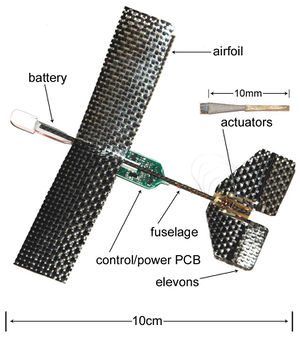Difference between revisions of "Media"
Jump to navigation
Jump to search
| Line 3: | Line 3: | ||
| style="width:50%"| | | style="width:50%"| | ||
== Paparazzi in the News == | == Paparazzi in the News == | ||
*[http://hjnews.townnews.com/articles/2008/07/12/news/news01.txt ‘Ghetto’ plane soars] | * [http://hjnews.townnews.com/articles/2008/07/12/news/news01.txt ‘Ghetto’ plane soars] | ||
*:<small>When a group of USU students arrived at a national robotic airplane contest, judges said their entry would never fly. | |||
</small> | </small> | ||
* [http://www.engineering.usu.edu/htm/engineering-news/news-articles/articleID=3579 Unmanned Aerial Vehicles Team Places 2nd at AUVSI Competition] - July 1, 2008 | * [http://www.engineering.usu.edu/htm/engineering-news/news-articles/articleID=3579 Unmanned Aerial Vehicles Team Places 2nd at AUVSI Competition] - July 1, 2008 | ||
*:<small>The Open Source Autonomous Multiple Unmanned Aerial Vehicles Build Fly and Beyond (OSAM-UAV-BFB) team of Austin Jensen, Cal Coopmans, Christopher Hall, Di Long, Haiyang Chao, Mitchel Humpherys, and team captain Daniel Morgan, won $8,000 of the $45,000 total prize money for 2nd place overall at the Association for Unmanned Vehicles Systems International (AUVSI) competition in St. Inigoes, Maryland in June. | *:<small>The Open Source Autonomous Multiple Unmanned Aerial Vehicles Build Fly and Beyond (OSAM-UAV-BFB) team of Austin Jensen, Cal Coopmans, Christopher Hall, Di Long, Haiyang Chao, Mitchel Humpherys, and team captain Daniel Morgan, won $8,000 of the $45,000 total prize money for 2nd place overall at the Association for Unmanned Vehicles Systems International (AUVSI) competition in St. Inigoes, Maryland in June. | ||
</small> | </small> | ||
* [http://www.flightglobal.com/articles/2008/04/03/222680/cots-uav-makes-arctic-debut.html Flight International: COTS UAV makes arctic debut] - April 3, 2008 | * [http://www.flightglobal.com/articles/2008/04/03/222680/cots-uav-makes-arctic-debut.html Flight International: COTS UAV makes arctic debut] - April 3, 2008 | ||
*:<small>A Norwegian university has flown an autonomous unmanned air vehicle equipped with meteorological sensors over the Spitzbergen/Svalbard island in the arctic circle in temperatures of -20 degrees C (-4 degrees F), winds up to 15m/s (50ft/s) and at an altitude of 4,900ft (1,500m). The Multiplex Funjet UAV was modified with electronics for open-source Paparazzi autopilot software… | *:<small>A Norwegian university has flown an autonomous unmanned air vehicle equipped with meteorological sensors over the Spitzbergen/Svalbard island in the arctic circle in temperatures of -20 degrees C (-4 degrees F), winds up to 15m/s (50ft/s) and at an altitude of 4,900ft (1,500m). The Multiplex Funjet UAV was modified with electronics for open-source Paparazzi autopilot software… | ||
| Line 56: | Line 58: | ||
*:Robots are often used in the media to instil fear with Frankenstein like stories of the scientist and corporation having gone to far with a humanoid machine destroying all before it. But on today's battlefield, and for this US Army sponsored event, and for the war of tomorrow the robots will, apparently, look more like model planes.</small> | *:Robots are often used in the media to instil fear with Frankenstein like stories of the scientist and corporation having gone to far with a humanoid machine destroying all before it. But on today's battlefield, and for this US Army sponsored event, and for the war of tomorrow the robots will, apparently, look more like model planes.</small> | ||
* [http://wissen.spiegel.de/wissen/dokument/dokument.html?id=31548470&top=SPIEGEL DER SPIEGEL: "Bierdeckel auf Spionageflug"] - July, 19, 2004 <small> | |||
*:Doch es gab auch Erfolge. Im Wettbewerb "autonomes MAV" etwa heimsten die Franzosen Antoine Drouin und Pascal Brisset von der Ecole Nationale de l'Aviation Civile souverän den ersten Preis ein. Vor allem der blaue Deltaflügler des Teams, Gewicht 425 Gramm, überzeugte die Jury. Nach erfolgreichem Start aus der Hand schaltete der mit einem Heckpropeller ausgestattete Flieger auf Autopilot und klapperte in geringer Höhe problemlos vier zuvor einprogrammierte Wegpunkte auf dem Flugfeld ab.</small> | |||
| | | | ||
Revision as of 08:58, 17 July 2008
Paparazzi in the News
|
Design Reports
Manuals
|
Other Sites of Interest
- "Design, Fabrication and Initial Results of a 2g Autonomous Glider"
(900K, PDF) - July 2007- Utilizing the core technologies of emerging microrobotic structures, the rapid design and prototyping of a passive micro air vehicle with the final goal of locating an audio source while avoiding hazardous obstacles is presented. The airfoil and control surfaces are optimized empirically to maximize lift and maneuverability while minimizing drag. Bimorph piezoelectric bending cantilevers actuate the control surfaces. Since such actuators require high voltages, an efficient boost circuit is presented along with appropriate high voltage electronics. To locate audio sources, a pair of acoustic sensors is designed and prototyped using a phase detection algorithm while a custom optic flow sensor is developed to avoid obstacles and give estimates of object distances and velocities. Finally, each subsystem is demonstrated and the complete glider is integrated to demonstrate initial open loop control performance.
